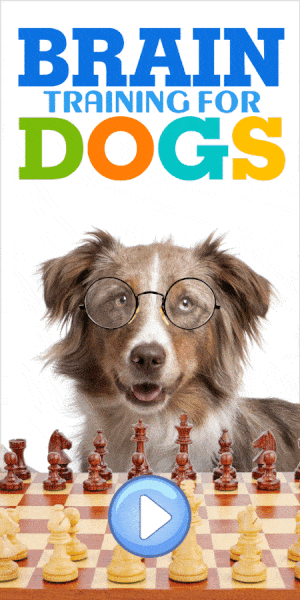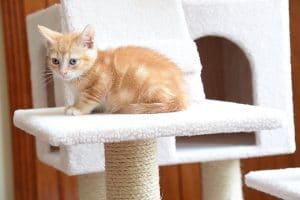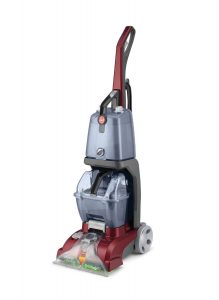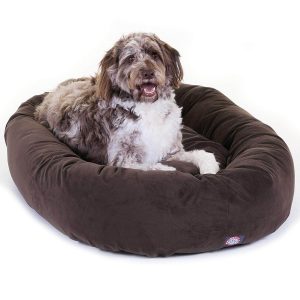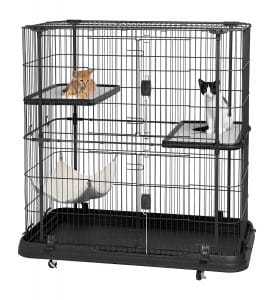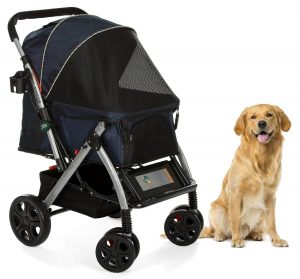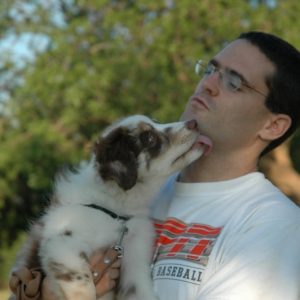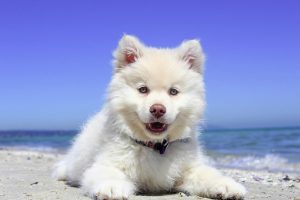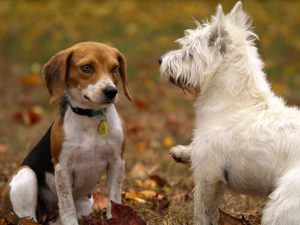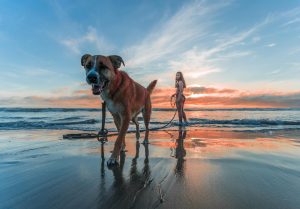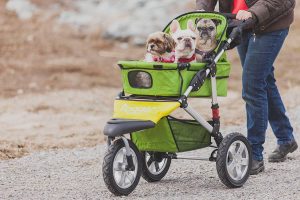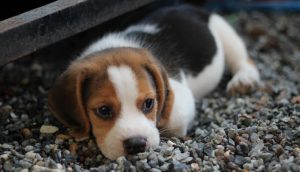 Separation anxiety can be a difficult behavior problem to deal with. In extreme situations, this problem can be one of the hardest to live with. Separation anxiety manifests itself in various behavioral patterns such as whining, barking, chewing doors and windows, destroying furniture, uncontrolled urinating and defecating in the house, and even self mutilation. The reason separation anxiety exists at all is the fact that dogs are highly social animals and as such, they need their social group to survive. In nature, wolves rarely find themselves alone; they are almost always with the pack. Even when they separate for hunting, they still usually stay in smaller groups. Our domestic dogs inherited the social needs of their ancestors and if it was up to them, they wouldn’t leave our sides for a single moment. However, the domestic dog did develop the ability to be left alone for rather long periods of time and it is the exception that problem behaviors due to separation arise.
Separation anxiety can be a difficult behavior problem to deal with. In extreme situations, this problem can be one of the hardest to live with. Separation anxiety manifests itself in various behavioral patterns such as whining, barking, chewing doors and windows, destroying furniture, uncontrolled urinating and defecating in the house, and even self mutilation. The reason separation anxiety exists at all is the fact that dogs are highly social animals and as such, they need their social group to survive. In nature, wolves rarely find themselves alone; they are almost always with the pack. Even when they separate for hunting, they still usually stay in smaller groups. Our domestic dogs inherited the social needs of their ancestors and if it was up to them, they wouldn’t leave our sides for a single moment. However, the domestic dog did develop the ability to be left alone for rather long periods of time and it is the exception that problem behaviors due to separation arise.
Many dog owners rush to the conclusion that their dog has separation anxiety. However, this is rarely the case. There are many simpler reasons why a dog is destructive in the house, barking constantly, or urinating in the house. Diagnosing separation anxiety should be done by a trained professional. Only after taking a long history of the dog’s behavior, meeting the dog, and even videotaping the dog when he is left alone, can a proper diagnosis takes place. Many dogs, for example, whine or bark when the owner leaves the house, but most of the time after only a few minutes they relax and mind their own business. Although this type of behavior can develop into separation anxiety, it is not the phenomenon itself. Separation anxiety is a state in which the dog cannot relax at all when left alone.
Although solving separation anxiety after it is already present can be very time consuming, preventing the problem from arising is significantly easier. However, it requires dog owners to gradually teach their puppies to be alone. Most dog owners do not do that.
 One of the biggest mistakes people do is not leaving the puppy alone at all in the first few weeks. Most people take a new puppy when they have a few months off from work and school – usually around summer time. In these months the puppy and the family are very happy with each other. The puppy is never alone and the family has endless time to spend with him. Then, summer is over. The parents go back to work and the kids back to school. The puppy goes from a state of constantly being with the pack, to being alone for 8-10 hours a day. From the puppy’s point of view – he was abandoned! When you think of it this way, it is very impressive how most puppies adapt to the new situation and learn to live with it. Nevertheless, some puppies begin to develop separation anxiety.
One of the biggest mistakes people do is not leaving the puppy alone at all in the first few weeks. Most people take a new puppy when they have a few months off from work and school – usually around summer time. In these months the puppy and the family are very happy with each other. The puppy is never alone and the family has endless time to spend with him. Then, summer is over. The parents go back to work and the kids back to school. The puppy goes from a state of constantly being with the pack, to being alone for 8-10 hours a day. From the puppy’s point of view – he was abandoned! When you think of it this way, it is very impressive how most puppies adapt to the new situation and learn to live with it. Nevertheless, some puppies begin to develop separation anxiety.
So what should you do? By all means, take a puppy when you have time. A puppy needs a lot of attention in the first few months and it would be wrong to take the commitment of raising a puppy during the busiest time of your life. However, make sure you gradually expose your puppy to being alone.
Getting used to being alone:
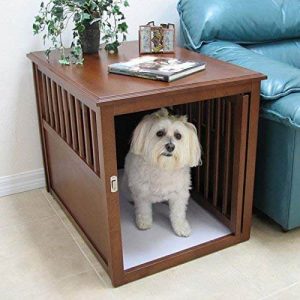
Every time the puppy is left alone, make sure he has toys or treats to accompany the lonely times. A stuffed KONG™ toy is a great option and there are many other toys on the market that can keep a dog’s attention for many happy minutes. Leave the fun toy a minute or two before you leave and leave the house while the dog is busy with the toy. When you get back home, take the toy away. You want to get to a point in which your dog is very happy to be with you but he is not sad when he is left alone. When he is alone, he gets to have fun with his favorite treats without anyone disturbing him. Combining this method with a long exercise session prior to leaving, can help prevent separation anxiety and general boredom and destructiveness.
People come and go – so what?
New puppy owners usually have a hard time leaving their puppies at home. Hence, they go through this emotional ritual before leaving. Emotional good byes accompanied by sentences like” I’m sorry I’m leaving, I will be back, don’t worry” and emotional returns, accompanied by sentences like” hello my love, sorry I was gone, I missed you so much” turn leaving the house and returning to the house to very emotional occurrences for the puppy. Due to those extended emotional states the puppy learns that goodbyes and hellos are extremely important events since the owner obviously finds them very disturbing. Therefore, the puppy believes he should also be concerned when these events take place.
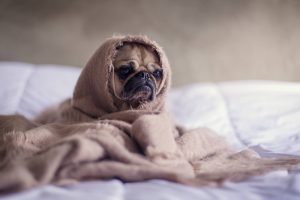
Text Box: Try to be as emotionless as possible during leaving the house and returning to it. When leaving, there is no need to say a word. Upon returning, wait with the petting and playing until your puppy stop his excitement from your return.
thus, I am not telling you to ignore your puppy and stop loving him. On the contrary, I hope that you will show your puppy all the love he deserves. I am saying that by choosing the correct moments to show this great love and affection, we can teach our puppies many nice behaviors. We can teach him that coming and going is not out of the ordinary and that fun, petting, and excitement happened in various times and are not connected directly to the events of leaving and returning.
We are creatures of habit:
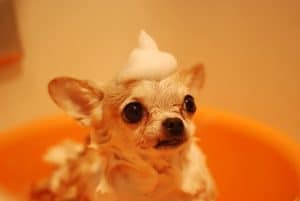
Our job is to avoid telling the dog that we are leaving. We can do this in two ways: 1) we can do our daily leaving routine many times but….end it by not leaving. We complete the routine and go watch TV. We complete the routine and go bake a cake, etc. if we do this enough times – this behavior chain no longer predicts leaving and your dog will be able to stay relaxed while it is happening. 2) We can try to vary our leaving routine. We can change the order of the things we do every day. One day, breakfast comes before getting dressed and on another day, we take the keys before we get dressed and eat. Doing this can prevent the dog from catching on to a behavior chain simply because it is constantly changing. This second method is usually harder for us but we can try to combine both methods to help our puppy stay relaxed before we really need to leave the house. Many dogs will stay relaxed if they were not able to build up stress as the behavior chain of leaving advances.
In Summary


